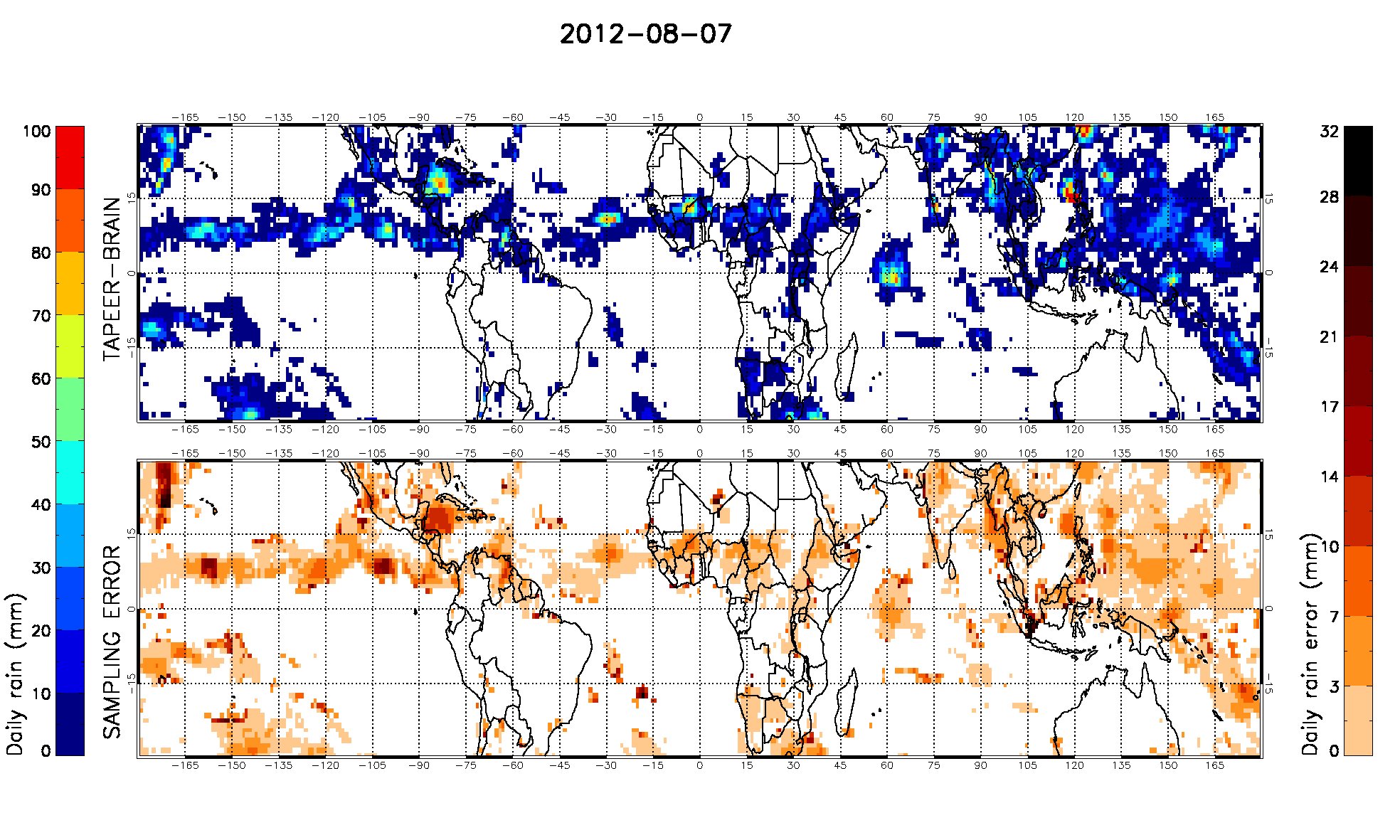The TAPEER-BRAIN algorithm combines microwave and infrared observations to provide precipitation estimates and associated errors bars at the one-degree/one-day accumulated scale.
TAPEER stands for Tropical Amount of Precipitation with an Estimate of ERrors. The major improvement in this 1.5 version of the TAPEER algorithm is to separately deal with rain detection and rain rates estimation. As a result different satellite configurations can be used for both aspects, in particular this allows to benefit from the use of microwave sounders for rain detection. The current implementation therefore relies on rain detection from LEO microwave imagers (TRMM/TMI, F15/SSMI, F16/SSMIS, F17/SSMIS, F18/SSMIS, GCOMW1/AMSR2) and sounders (MT/SAPHIR) as well as instantaneous precipitation retrievals from LEO microwave imagers using the BRAIN algorithm (Viltard et al, 2006). Those detections and rain rates estimates are then merged with full space/time resolution data from the thermal window channel onboard GEO platforms (MSG, Meteosat7, GOES-E, GOES-W, MTSAT, HIMAWARI). The product is further corrected statistically using the TRMM PR v7 near surface rain rates data.
These new development are presented at length in Roca et al. (2017).
The product looks like the figure below with the daily accumulation and the sampling error both expressed in mm.

Figure 1 Illustration of a typical TAPEER-BRAIN product. Top: daily accumulated rainfall (mm). Bottom: sampling error (mm)
The details of the algorithm are available in the Megha-Tropiques Technical Memorandum n°4 (Chambon et al.,2012a, Roca et al., 2014) while the scientific background on both the algorithm and the error modeling effort are presented in (Roca et al; 2010; Chambon et al., 2012b).
The product has been going under a careful and systematic physical validation phase and the results are reported in Gosset et al (2017).
Documentation
Product Definition Document: TAPEER-BRAIN L4 surface accumulated rainfall products
Contact
For more information, contact Rémy Roca (remy.roca@legos.obs-mip.fr).
References
Chambon P., R Roca, I Jobard, J Aublanc 2012a, TAPEER-BRAIN product: Algorithm Theoritical Basis Document, Level-4,Megha-Tropiques Technical Memorandum n°4, 13 pp.
Chambon P, Jobard I, Roca R, Viltard N. 2012b An investigation of the error budget of tropical rainfall accumulation derived from merged passive microwave and infrared satellite measurements. Q. J. R. Meteorol. Soc. 138: 000.000. DOI:10.1002/qj.1907
Gosset et al., Validation of the TAPEER product over West Africa, 2017, in preparation for the Special Collection “Advances in Remote Sensing of Rainfall and Snowfall”, Q. J. R. Meteorol. Soc.
Roca R., P Chambon, Jobard I, P-E Kirstetter, M Gosset, JC Bergès, 2010, Comparing Satellite and Surface Rainfall Products over West Africa at Meteorologically Relevant Scales during the AMMA Campaign Using Error Estimates, J. App. Met. Clim. Volume 49, Issue 4 , pp. 715-731.
Roca R., J. Aublanc, P.Chambon, T. Fiolleau, and N. Viltard, 2014 Robust observational quantification of the contribution of mesoscale convective systems to rainfall in the tropics, J Climate, 27, 4952-4958. doi: http://dx.doi.org/10.1175/JCLI-D-13-00628.1
Roca et al., 2017, Quantifying the contribution of the Megha-Tropiques mission to the estimation of daily accumulated rainfall in the Tropics, in preparation for the Special Collection “Advances in Remote Sensing of Rainfall and Snowfall”, Q. J. R. Meteorol. Soc.
Viltard, N., C. Burlaud, and C.D. Kummerow, 2006: Rain Retrieval from TMI Brightness Temperature Measurements Using a TRMM PR-Based Database. J. Appl. Meteor. Climatol., 45, 455-466.